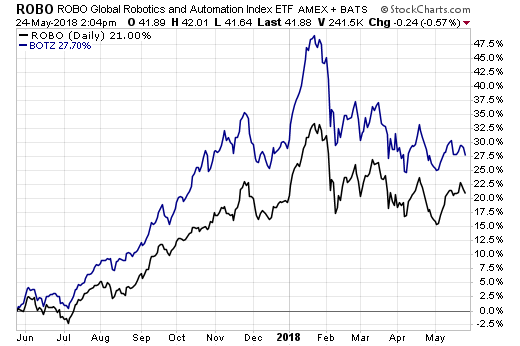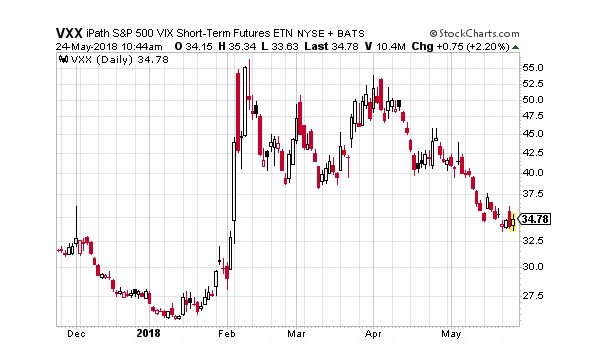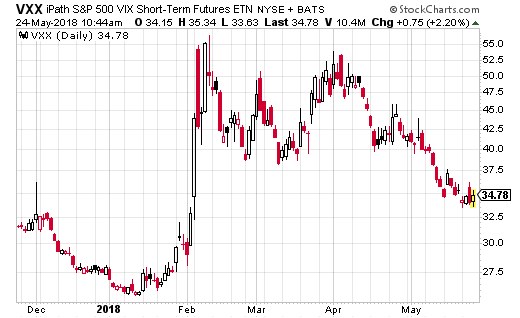The two ETFs I like are the Global X Funds Robotics & Artificial Intelligence ETF (Nasdaq: BOTZ) and the ROBO Global Robotics & Automation Index ETF (Nasdaq: ROBO). I am very positive on both of these ETFs and have previously recommended them to investors.
As you might surmise, there are a lot of similarities between the two funds as they both focus on what we might generally call robotics and automation.
But there are subtle differences. ROBO is older with an inception date of 10-22-2013, while BOTZ came to market on 09-12-2016. BOTZ is more liquid than ROBO with 88.9 million shares outstanding and an average trading volume of about two million shares a day. That compares with ROBO’s 53 million shares outstanding and average daily trading volume in the range of 700,000 shares.
BOTZ does have an edge when it comes to expenses with a lower expense ratio than ROBO – 0.68% versus 0.95% – which factors into the long-term performance of any fund or ETF.
Portfolio Differences
Most important, of course, when comparing the two ETFs is the difference in their portfolios. And here BOTZ has a more concentrated portfolio with only 29 stocks versus the 93 stocks in the ROBO portfolio. That will likely make it somewhat more volatile and risky.
Related: Buy This Robotics Stock Before the Machines Take Over
If you look at the geographic exposure of the two funds – with my preference for exposure to the leaders in the industry, which are Japanese – here BOTZ has the upper hand with about 50% of the fund in Japanese stocks versus only 28% for ROBO.
However, when it comes down to the actual stocks in the portfolios, both are outstanding. That’s why I’m adding both to our own portfolio. Here are the top 10 positions for each ETF:
Top 10 Positions for the Global X Robotics & Artificial Intelligence ETF
- Nvidia
- Yaskawa Electric (Japan)
- Fanuc Corporation (Japan)
- Keyence Corporation (Japan)
- Intuitive Surgical
- Mitsubishi Electric (Japan)
- ABB Ltd. (Europe)
- SMC Corporation (Japan)
- Daifuku Company Ltd. (Japan)
- Omron Corporation (Japan)
Top 10 Positions for the ROBO Global Robotics & Automation Index ETF
- iRobot
- Daifuku Company Ltd. (Japan)
- IPG Photonics
- Nabtesco Corporation (Japan)
- Hiwin Technologies (Taiwan)
- Yaskawa Electric (Japan)
- Fanuc Corporation (Japan)
- Intuitive Surgical
- Mazor Robotics
- Oceaneering International
Over the past year, BOTZ returned 27% while ROBO gained 21%, both easily outperforming the S&P 500 index. As you can see they were both on a tear and shot up too fast right before the February correction. They’ve since dropped back down in what one might call consolidation. With the bright future I see for the robotics industry, I expect the outperformance to start again and to continue for many years.
3 Tech Stocks That Could Go to 2,524%!
Don’t risk your money on IPOs, risky tech startups… or the next Pets.com, Snapchat, Groupon, Webvan hyped by the financial media as the next big thing… all of them black holes for investors’ hard earned money. Instead, bank on these 3 high-growth tech stocks that offer a high likelihood of outperformance in the near-term, and a chance of TRIPLING – even quadrupling – before the end of the year!
Buffett just went all-in on THIS new asset. Will you?Buffett could see this new asset run 2,524% in 2018. And he's not the only one... Mark Cuban says "it's the most exciting thing I've ever seen." Mark Zuckerberg threw down $19 billion to get a piece... Bill Gates wagered $26 billion trying to control it...
What is it?
It's not gold, crypto or any mainstream investment. But these mega-billionaires have bet the farm it's about to be the most valuable asset on Earth. Wall Street and the financial media have no clue what's about to happen...And if you act fast, you could earn as much as 2,524% before the year is up.
Click here to find out what it is.



